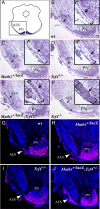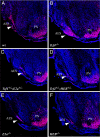The E-protein Tcf4 interacts with Math1 to regulate differentiation of a specific subset of neuronal progenitors
- PMID: 17878293
- PMCID: PMC1978485
- DOI: 10.1073/pnas.0707456104
The E-protein Tcf4 interacts with Math1 to regulate differentiation of a specific subset of neuronal progenitors
Abstract
Proneural factors represent <10 transcriptional regulators required for specifying all of the different neurons of the mammalian nervous system. The mechanisms by which such a small number of factors creates this diversity are still unknown. We propose that proteins interacting with proneural factors confer such specificity. To test this hypothesis we isolated proteins that interact with Math1, a proneural transcription factor essential for the establishment of a neural progenitor population (rhombic lip) that gives rise to multiple hindbrain structures and identified the E-protein Tcf4. Interestingly, haploinsufficiency of TCF4 causes the Pitt-Hopkins mental retardation syndrome, underscoring the important role for this protein in neural development. To investigate the functional relevance of the Math1/Tcf4 interaction in vivo, we studied Tcf4(-/-) mice and found that they have disrupted pontine nucleus development. Surprisingly, this selective deficit occurs without affecting other rhombic lip-derived nuclei, despite expression of Math1 and Tcf4 throughout the rhombic lip. Importantly, deletion of any of the other E-protein-encoding genes does not have detectable effects on Math1-dependent neurons, suggesting a specialized role for Tcf4 in distinct neural progenitors. Our findings provide the first in vivo evidence for an exclusive function of dimers formed between a proneural basic helix-loop-helix factor and a specific E-protein, offering insight about the mechanisms underlying transcriptional programs that regulate development of the mammalian nervous system.
Conflict of interest statement
The authors declare no conflict of interest.
Figures






Similar articles
-
Math1 is expressed in temporally discrete pools of cerebellar rhombic-lip neural progenitors.Neuron. 2005 Oct 6;48(1):17-24. doi: 10.1016/j.neuron.2005.08.028. Neuron. 2005. PMID: 16202705
-
Antagonism between Notch and bone morphogenetic protein receptor signaling regulates neurogenesis in the cerebellar rhombic lip.Neural Dev. 2007 Feb 23;2:5. doi: 10.1186/1749-8104-2-5. Neural Dev. 2007. PMID: 17319963 Free PMC article.
-
Helt determines GABAergic over glutamatergic neuronal fate by repressing Ngn genes in the developing mesencephalon.Development. 2007 Aug;134(15):2783-93. doi: 10.1242/dev.02870. Epub 2007 Jul 4. Development. 2007. PMID: 17611227
-
Context dependence of proneural bHLH proteins.Curr Opin Genet Dev. 2008 Oct;18(5):411-7. doi: 10.1016/j.gde.2008.07.012. Epub 2008 Sep 7. Curr Opin Genet Dev. 2008. PMID: 18722526 Free PMC article. Review.
-
Proneural bHLH genes in development and disease.Curr Top Dev Biol. 2014;110:75-127. doi: 10.1016/B978-0-12-405943-6.00002-6. Curr Top Dev Biol. 2014. PMID: 25248474 Review.
Cited by
-
PGC1α Loss Promotes Lung Cancer Metastasis through Epithelial-Mesenchymal Transition.Cancers (Basel). 2021 Apr 8;13(8):1772. doi: 10.3390/cancers13081772. Cancers (Basel). 2021. PMID: 33917757 Free PMC article.
-
The quest for restoring hearing: Understanding ear development more completely.Bioessays. 2015 Sep;37(9):1016-27. doi: 10.1002/bies.201500044. Epub 2015 Jul 24. Bioessays. 2015. PMID: 26208302 Free PMC article. Review.
-
ATOH7 mutations cause autosomal recessive persistent hyperplasia of the primary vitreous.Hum Mol Genet. 2012 Aug 15;21(16):3681-94. doi: 10.1093/hmg/dds197. Epub 2012 May 29. Hum Mol Genet. 2012. PMID: 22645276 Free PMC article.
-
Complex translocation disrupting TCF4 and altering TCF4 isoform expression segregates as mild autosomal dominant intellectual disability.Orphanet J Rare Dis. 2016 May 14;11(1):62. doi: 10.1186/s13023-016-0439-6. Orphanet J Rare Dis. 2016. PMID: 27179618 Free PMC article.
-
Pitt-Hopkins Syndrome.Mol Syndromol. 2012 Apr;2(3-5):171-180. doi: 10.1159/000335287. Epub 2011 Dec 29. Mol Syndromol. 2012. PMID: 22670138 Free PMC article.
References
-
- Guillemot F. Curr Opin Cell Biol. 2005;17:639–647. - PubMed
-
- Ross SE, Greenberg ME, Stiles CD. Neuron. 2003;39:13–25. - PubMed
-
- Bertrand N, Castro DS, Guillemot F. Nat Rev Neurosci. 2002;3:517–530. - PubMed
-
- Guillemot F, Lo LC, Johnson JE, Auerbach A, Anderson DJ, Joyner AL. Cell. 1993;75:463–476. - PubMed
Publication types
MeSH terms
Substances
Grants and funding
LinkOut - more resources
Full Text Sources
Other Literature Sources
Medical
Molecular Biology Databases

